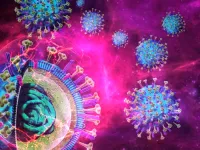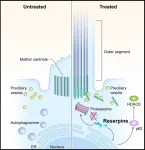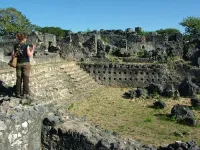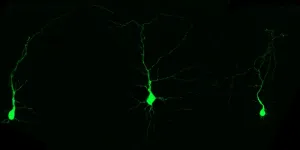(Press-News.org) (MEMPHIS, Tenn. – March 29, 2023) Improving the seasonal influenza vaccine and public health specialists’ ability to predict pandemic potential in new flu strains may be possible due to new findings from scientists at St. Jude Children’s Research Hospital. The key is the stability of a viral protein that gains entry into human cells. The findings were published today in Science Advances.
“We found that the protein flu viruses use to enter cells, hemagglutinin, needs to be relatively stable and resistant to acid in an effective H3N2 flu vaccine,” said senior and co-corresponding author Charles Russell, Ph.D., St. Jude Department of Infectious Diseases. “We found a mutation in hemagglutinin that makes the virus grow better in eggs also causes a mismatch in the vaccine. The mutation makes the virus unstable and makes it look less human-like.”
The H3N2 virus is a subtype of Influenza A and is one of the culprits behind the seasonal flu. Many flu vaccines are made by growing the virus in chicken eggs, but the virus can gain mutations during that process. Some of those changes, like the one uncovered by the St. Jude group, make the vaccine less effective in generating the ideal immune response. At the same time, other mutations have more beneficial impacts.
“We also found a different mutation in egg adaptation that doesn’t destabilize the hemagglutinin or make it less human-like,” Russell said. “That mutation prevented the emergence of the destabilizing mutant. Going forward, incorporating this protective mutation or otherwise assuring hemagglutinin stability may help maintain vaccine efficacy.”
While egg-adaptive mutations are a well-known weakness in many current flu vaccine pipelines, scientists currently do not consider viral protein stability when assessing flu strains to include in the annual vaccine. This study suggests that testing flu strains’ hemagglutinin for an antigenic match to circulating viruses, then including only those with higher stability, may improve the vaccine by preventing the incorporation of strains with unstable proteins.
Predicting influenza pandemic potential
The scientists also found that hemagglutinin stability could be measured to better predict the pandemic potential of novel flu strains. Flu viruses with the unstable protein could not transmit in the air between ferrets, a model used to infer likely properties in humans. Moreover, viruses with the more stable protein version had a high airborne transmission rate.
“The top of the lungs and nose, called the upper respiratory tract, is mildly acidic,” Russell said. “The viral protein needs to be able to resist mild acid when it’s outside of the cell in the respiratory tract. That’s why the stable hemagglutinin improves transmission.”
Hemagglutinin is like a mousetrap, ready to strike and poke into a human cell when exposed to enough acid. If unstable proteins trigger too early in the mildly acidic lung environment, the virus can’t enter any cells.
But if the viral protein is too stable, it can also be a problem for the virus. Previous research showed that too much stability delays the virus from infecting new cells. The St. Jude group’s work shows that a pandemic flu virus must fall in the stability ‘sweet spot’ — stable enough to make it through the mildly acidic lung environment but unstable enough to infect quickly when they reach the appropriate part of cells.
Both the Centers for Disease Control (CDC) and World Health Organization (WHO) monitor for potential pandemic flu viruses worldwide. They currently watch for well-known mutations that switch an avian flu virus to one that can enter humans, including those that change the receptors to which hemagglutinin can bind. This study adds to a growing body of work characterizing the other changes needed for an avian virus to jump into humans.
“In addition to changes in receptor binding, there are a few other properties that we know that have to change too, and they’re not currently well accounted for in risk assessment, due to a lack of feasibility. But for hemagglutinin stability, it’s a simple concept to expose it to different acidities and measure the remaining infectivity of a virus,” said Russell.
Therefore, the study’s results suggest that by incorporating a simple experiment testing hemagglutinin stability, scientists may be able to better assess the pandemic potential risk of novel influenza viruses.
Authors and funding
The study’s first author is Meng Hu, and the co-corresponding author is Richard Webby, both of St. Jude Children’s Research Hospital. The other authors are Christina Kackos, Balaji Banoth, Chet Raj Ojha, Jeremy Jones and Shaohua Lei of St. Jude and Lei Li, Weill Cornell Medicine.
The study was supported by contracts and grants from the National Institute of Allergy and Infectious Diseases (75N93019C00052, HHSN272201400006C and 75N93021C00016) and ALSAC, the fundraising and awareness organization of St. Jude.
St. Jude Media Relations Contacts
Michael Sheffield
Desk: (901) 595-0221
Cell: (901) 379-6072
michael.sheffield@stjude.org
media@stjude.org
Emily Gest
Desk: (901) 595-0260
Cell: (901) 568-9869
emily.gest@stjude.org
media@stjude.org
St. Jude Children's Research Hospital
St. Jude Children's Research Hospital is leading the way the world understands, treats, and cures childhood cancer, sickle cell disease and other life-threatening disorders. It is the only National Cancer Institute-designated Comprehensive Cancer Center devoted solely to children. Treatments developed at St. Jude have helped push the overall childhood cancer survival rate from 20% to 80% since the hospital opened more than 60 years ago. St. Jude shares the breakthroughs it makes to help doctors and researchers at local hospitals and cancer centers around the world improve the quality of treatment and care for even more children. To learn more, visit stjude.org, read St. Jude Progress blog, and follow St. Jude on social media at @stjuderesearch.
END
Method for improving seasonal flu vaccines also aids pandemic prediction
Scientists at St. Jude Children’s Research Hospital found mutations that can improve or impair flu vaccines and may give clues to assess the pandemic potential of flu viruses in nature.
2023-03-29
ELSE PRESS RELEASES FROM THIS DATE:
Model for predicting transmission of COVID-19 can help policymakers monitor virus, inform health surveillance systems
2023-03-29
The COVID-19 pandemic presents unprecedented challenges to public health worldwide. Tracking the dynamics of the coronavirus permits governments, organizations, and individuals to make projections in an effort to curb the spread of the pandemic. But while a large amount of data about COVID is collected and publicly available, the information can be unreliable and subject to bias. In a new study, researchers analyzed data from Cali, Colombia, to develop a model that provides a template for tracking data, predicting transmission, and informing health surveillance systems.
The study was conducted by researchers at Carnegie Mellon ...
FDA-approved drug shows promise in lab models for blinding childhood disease
2023-03-29
A National Eye Institute-led team has identified a compound already approved by the U.S. Food and Drug Administration that keeps light-sensitive photoreceptors alive in three models of Leber congenital amaurosis type 10 (LCA 10), an inherited retinal ciliopathy disease that often results in severe visual impairment or blindness in early childhood.
LCA 10 is caused by mutations of the cilia-centrosomal gene (CEP290). Such mutations account for 20% to 25% of all LCA – more than any other gene.
Using a mouse model of LCA10 and two types of lab-created tissues from stem ...
OHIO diabetes researchers discover the potential of CIDEC protein to mitigate obesity-related cardiometabolic disease
2023-03-29
A team of researchers from Ohio University’s Heritage College of Osteopathic Medicine recently discovered a novel role of human-CIDEC gene in improving metabolic dysfunction and cardiovascular health. The study, “Endothelial-Specific Expression of CIDEC Improves High-Fat Diet–Induced Vascular and Metabolic Dysfunction,” published in Diabetes focuses on vascular function and its association with metabolic diseases like insulin resistance, Type 2 diabetes, and cardiovascular disease.
“This is a very impactful study, and we have moved in the right direction to find a way to reduce cardiovascular ...
The COVID-19 pandemic has increased – but also polarised – trust in science
2023-03-29
Research by the Milner Centre for Evolution at the University of Bath, UK, along with colleagues at Universities of Oxford and Aberdeen, finds that trust in scientists has hugely increased overall since the COVID-19 pandemic, but that attitudes have also become more polarized. The study also found that people were more likely to take the COVID-19 vaccine if their trust in the science had increased.
Whether it be climate change, vaccines or GM foods, trust in science and scientists has rarely been more important. ...
DoD funds new project aimed at protecting global supply chains, infrastructure
2023-03-29
Thanks to the work of Arizona Sen. Mark Kelly, a new project led by Northern Arizona University, with various collaborators throughout the nation, will help the United States better protect the critical supply chain infrastructure and the supply chains that keeps the country and its economy running.
Benjamin Ruddell, professor in the School of Informatics, Computing, and Cyber Systems and founder of the FEWSION project, is the NAU lead. Funded at $8 million for year one, the project aims to work with technology known as Fused Global Data Analytics and Visualization. The team’s leadership, ...
CNIO researchers help to understand the functioning of the protein that makes DNA loops in the human genome
2023-03-29
Cohesin is a ring-shaped protein that surrounds and moves around the DNA molecule, forming the loops. It is a crucial process for the cell.
Understanding how cohesin works has been one of the challenges of molecular biology in recent decades.
The work now published by Ana Losada's group at CNIO will serve to deepen our understanding of the disease known as Cornelia de Lange syndrome.
At the end of the 1990s, Ana Losada, a researcher at the Spanish National Cancer Research Centre (CNIO), then at the Cold Spring Harbor Laboratory (New York, USA), discovered a protein in frogs of the Xenopus genus that is fundamental to ...
AI could set a new bar for designing hurricane-resistant buildings
2023-03-29
Being able to withstand hurricane-force winds is the key to a long life for many buildings on the Eastern Seaboard and Gulf Coast of the U.S. Determining the right level of winds to design for is tricky business, but support from artificial intelligence may offer a simple solution.
Equipped with 100 years of hurricane data and modern AI techniques, researchers at the National Institute of Standards and Technology (NIST) have devised a new method of digitally simulating hurricanes. The results of a study published today in Artificial Intelligence for the Earth Systems demonstrate that the simulations can accurately ...
Caesarean Scar Disorder: International study led by Amsterdam UMC defines a clinical condition
2023-03-29
More than 30% of women who give birth by caesarean section suffer from long-term symptoms, such as abdominal pain, blood loss or fertility problems. These symptoms are caused by an abnormal uterine scar. This condition is defined now for the first time, thanks to an international study led by Amsterdam UMC, as Caesarean Scar Disorder (CSDi). This gives women recognition for these problems after a caesarean section. In addition, international studies on CSDi can now be better compared with each other, providing more insight into treatment options. The research is published today in JAMA Network Open.
In ...
Ancient DNA reveals African and Asian ancestry of medieval Swahili people
2023-03-29
People living on the ‘Swahili coast’ - the Indian Ocean coast of eastern Africa - have African and Asian ancestry according to new research on ancient DNA.
Archaeologists believe that the results, based on finds from excavations, including those directed by Professor Stephanie Wynne-Jones from the University of York and Professor Jeffrey Fleisher at Rice University, confirm that relationships between Asian merchants and African traders were formed between the years 900 and 1100 in ...
Feed them or lose them
2023-03-29
Brain development consists of a sequence of coordinated steps, which are mainly instructed by our genes. During these steps, the proper positioning and functionality of nerve cells in the brain (neurons) are critical—nonfunctional or incorrectly positioned neurons can lead to severe neuropathological consequences. Mutations in genes coordinating this program are often linked to neurodevelopmental disorders; however, environmental stressors such as nutrient scarcity or malnutrition can also influence the development of the brain. Still, very little is known about the importance of specific nutrients ...
LAST 30 PRESS RELEASES:
Making lighter work of calculating fluid and heat flow
Normalizing blood sugar can halve heart attack risk
Lowering blood sugar cuts heart attack risk in people with prediabetes
Study links genetic variants to risk of blinding eye disease in premature infants
Non-opioid ‘pain sponge’ therapy halts cartilage degeneration and relieves chronic pain
AI can pick up cultural values by mimicking how kids learn
China’s ecological redlines offer fast track to 30 x 30 global conservation goal
Invisible indoor threats: emerging household contaminants and their growing risks to human health
Adding antibody treatment to chemo boosts outcomes for children with rare cancer
Germline pathogenic variants among women without a history of breast cancer
Tanning beds triple melanoma risk, potentially causing broad DNA damage
Unique bond identified as key to viral infection speed
Indoor tanning makes youthful skin much older on a genetic level
Mouse model sheds new light on the causes and potential solutions to human GI problems linked to muscular dystrophy
The Journal of Nuclear Medicine ahead-of-print tip sheet: December 12, 2025
Smarter tools for peering into the microscopic world
Applications open for funding to conduct research in the Kinsey Institute archives
Global measure underestimates the severity of food insecurity
Child survivors of critical illness are missing out on timely follow up care
Risk-based vs annual breast cancer screening / the WISDOM randomized clinical trial
University of Toronto launches Electric Vehicle Innovation Ontario to accelerate advanced EV technologies and build Canada’s innovation advantage
Early relapse predicts poor outcomes in aggressive blood cancer
American College of Lifestyle Medicine applauds two CMS models aligned with lifestyle medicine practice and reimbursement
Clinical trial finds cannabis use not a barrier to quitting nicotine vaping
Supplemental nutrition assistance program policies and food insecurity
Switching immune cells to “night mode” could limit damage after a heart attack, study suggests
URI-based Global RIghts Project report spotlights continued troubling trends in worldwide inhumane treatment
Neutrophils are less aggressive at night, explaining why nighttime heart attacks cause less damage than daytime events
Menopausal hormone therapy may not pose breast cancer risk for women with BRCA mutations
Mobile health tool may improve quality of life for adolescent and young adult breast cancer survivors
[Press-News.org] Method for improving seasonal flu vaccines also aids pandemic predictionScientists at St. Jude Children’s Research Hospital found mutations that can improve or impair flu vaccines and may give clues to assess the pandemic potential of flu viruses in nature.




